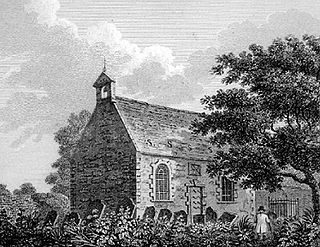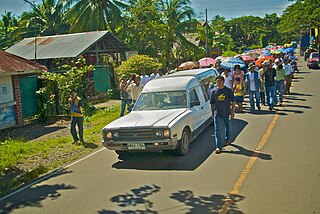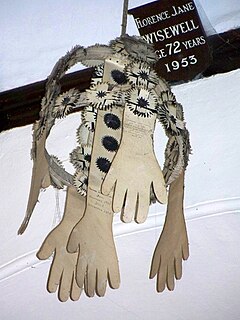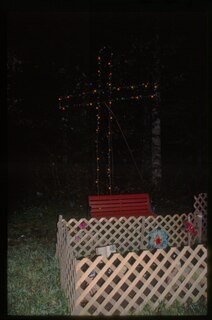Related Research Articles

All Souls' Day, also known as the Commemoration of All the Faithful Departed and the Day of the Dead, is a day of prayer and remembrance for the souls of those who have died, which is observed by Catholics and other Christian denominations annually on November 2. All Souls' Day is often celebrated in Western Christianity; Saturday of Souls is a related tradition more frequently observed in Eastern Christianity. Practitioners of All Souls' Day traditions often remember deceased loved ones in various ways on the day. Beliefs and practices associated with All Souls' Day vary widely among Christian denominations.

A funeral is a ceremony connected with the final disposition of a corpse, such as a burial or cremation, with the attendant observances. Funerary customs comprise the complex of beliefs and practices used by a culture to remember and respect the dead, from interment, to various monuments, prayers, and rituals undertaken in their honor. Customs vary between cultures and religious groups. Common secular motivations for funerals include mourning the deceased, celebrating their life, and offering support and sympathy to the bereaved; additionally, funerals may have religious aspects that are intended to help the soul of the deceased reach the afterlife, resurrection or reincarnation.

Palm Sunday is a Christian moveable feast that falls on the Sunday before Easter. The feast commemorates Jesus' triumphal entry into Jerusalem, an event mentioned in each of the four canonical Gospels. Palm Sunday marks the first day of Holy Week, the last week of the Christian solemn season of Lent that precedes the arrival of Eastertide.

The veneration of the dead, including one's ancestors, is based on love and respect for the deceased. In some cultures, it is related to beliefs that the dead have a continued existence, and may possess the ability to influence the fortune of the living. Some groups venerate their direct, familial ancestors. Certain sects and religions, in particular the Eastern Orthodox Church and Roman Catholic Church, venerate saints as intercessors with God; the latter also believes in prayer for departed souls in Purgatory. Other religious groups, however, consider veneration of the dead to be idolatry and a sin.

Glasnevin Cemetery is a large cemetery in Glasnevin, Dublin, Ireland which opened in 1832. It holds the graves and memorials of several notable figures, and has a museum.

Memorial Day is a federal holiday in the United States for honoring and mourning the military personnel who have died while serving in the United States Armed Forces. The holiday is observed on the last Monday of May. The holiday was formerly observed on May 30 from 1868 to 1970.

Michaelmas is a Christian festival observed in some Western liturgical calendars on 29 September. In some denominations a reference to a fourth angel, usually Uriel, is also added. Michaelmas has been one of the four quarter days of the financial, judicial, and academic year.

A wreath is an assortment of flowers, leaves, fruits, twigs, or various materials that is constructed to form a ring.
A pattern in Irish Roman Catholicism refers to the devotions that take place within a parish on the feast day of the patron saint of the parish, on that date, called a Pattern day, or the nearest Sunday, called Pattern Sunday. In the case of a local folk saint from Celtic Christianity, there may be archaeological remains traditionally associated with the saint, such as holy wells reputed to have healing powers. Often the parish priest will say Mass or lead prayers at such a site, sometimes processing between several locations. In some parishes, Pattern Sunday coincides with Cemetery Sunday, an annual ancestor veneration observance held in cemeteries which typically includes the cleaning and decoration of family graves as well as religious rituals.

Radonitsa, also spelled Radunitsa, Radonica, or Radunica, in the Russian Orthodox Church is a commemoration of the departed observed on the second Tuesday of Pascha (Easter) or, in some places, on the second Monday of Pascha. In Ukrainian tradition it is called Provody (Проводи).
Icelandic funerals are ceremonies that are largely shaped by the Evangelical Lutheran Church of Iceland, the largest Christian organisation in Iceland. However, customs may vary depending on religious group.

All Saints' Day, also known as All Hallows' Day, Hallowmas, the Feast of All Saints, or Solemnity of All Saints, is a Christian solemnity celebrated in honour of all the saints, known and unknown. Its intent is to celebrate all the saints, including those who do not, or are no longer, celebrated individually, either because the number of saints has become so great or because they were celebrated in groups, after suffering martyrdom collectively. From the 4th century, feasts commemorating all Christian martyrs were held in various places on various dates near Easter and Pentecost. In the 9th century, some churches in the British Isles began holding the commemoration of all saints on 1 November, and in the 10th century this was extended to the whole church by Pope Gregory IV.

Bluebell is a small suburb of Dublin City, Ireland. Situated approximately 6.5 kilometres south-west of the city centre on the Camac, a Liffey tributary, the suburb borders the Grand Canal and Inchicore to the north, Walkinstown to the south, Drimnagh to the east, and Kylemore to the west.

Drumcondra Church of Ireland is a Church of Ireland church located in Drumcondra, Dublin, previously in the Civil Parish of Clonturk. The church and its churchyard contain memorials to a number of notable historical figures.

St. James' Church, a former Church of Ireland church in James's Street, Dublin, Ireland, was established in 1707. The corresponding parish, which was separated from that of nearby St. Catherine's, was established in 1710. There had been a shrine dedicated to St. James at nearby St. James's Gate, a stopping-off point for pilgrims, since medieval times. It has been proposed that the current church is near to the site of a church to St. James of Compostella which is first referred to in the mid-13th century.

During the Pre-Hispanic period the early Filipinos believed in a concept of life after death. This belief, which stemmed from indigenous ancestral veneration and was strengthened by strong family and community relations within tribes, prompted the Filipinos to create burial customs to honor the dead through prayers and rituals. Due to different cultures from various regions of the Philippines, many different burial practices have emerged. For example, the Manobos buried their dead in trees, the Ifugaos seated the corpse on a chari before it was brought to a cave and buried elsewhere. The most common forms of traditional burials are supine pits, earthenware jars, and log coffins, and have been a topic of interest among Philippine archaeologists since the early 20th century.

Rushbearing is an old English ecclesiastical festival in which rushes are collected and carried to be strewn on the floor of the parish church. The tradition dates back to the time when most buildings had earthen floors and rushes were used as a form of renewable floor covering for cleanliness and insulation. The festival was widespread in Britain from the Middle Ages and well established by the time of Shakespeare, but had fallen into decline by the beginning of the 19th century, as church floors were flagged with stone. The custom was revived later in the 19th century and is kept alive today as an annual event in a number of towns and villages in the north of England.

A maiden's garland, also known as a virgin's crown, crants or crantsey, is a crown-shaped garland used as a funeral memento for, usually female, virgins. They are generally made of paper flowers, rosettes and ribbons fixed to a wooden frame. Many are also adorned with white paper gloves, and may be inscribed with verses of poetry and the name of the deceased. The garlands are carried before, or on, the coffin during the funeral procession and afterwards displayed in the church. W. R. Bullen, writing in The Tablet in 1926, reports that the "practice of carrying garlands at a maiden's funeral was common in England, Wales and Scotland before the Reformation and after it for two hundred years or more, but the custom has now almost entirely fallen into disuse." Shakespeare refers to the custom in his play Hamlet, when describing the burial of Ophelia:
her death was doubtful,
and, but that great command o'ersways the order,
she should in ground unsanctified have lodged
till the last trumpet; for charitable prayers,
shards, flints and pebbles should be thrown on her;
yet here she is allow'd her virgin crants,her maiden strewments, and the bringing home of bell and burial.

Decoration Days in Southern Appalachia and Liberia are a living tradition of group ancestor veneration observances which arose by the 19th century. While Decoration practices are localized and can be unique to individual families, cemeteries, and communities, common elements unify the various Decoration Day practices and are thought to represent syncretism of Christian cultures in 19th century Southern Appalachia with pre-Christian influences from the British Isles and Africa. Appalachian and Liberian cemetery decoration traditions pre-date the United States Memorial Day holiday.

In southern Wales and nearby portions of England, Sul y Blodau or Flowering Sunday is a grave decoration tradition commonly observed on Palm Sunday, although historically Flowering Sunday grave decoration was also observed on other days as well. It is traditional to whitewash and decorate graves with flowers on Flowering Sunday. Today, the names Palm Sunday and Flowering Sunday are used interchangeably in Wales. Scholars Alan and Karen Jabbour have postulated that Flowering Sunday might be connected to Appalachian and Liberian Decoration Day cemetery traditions. Flowering Sunday is also known as Blossom Sunday in some portions of England.
References
- 1 2 Rennicks, Rich. "Cemetery Sunday in Ireland". A Trip to Ireland. Archived from the original on 22 February 2019. Retrieved 14 September 2019.
- 1 2 3 4 5 Graham, Barbara (2016). Death, Materiality and Mediation: An Ethnography of Remembrance in Ireland. Berghahn Books.
- ↑ "Cemetery Sunday". Archdiocese of Newark . Retrieved 5 August 2013.
- ↑ Murphey, Sean. "The Story of St. James Fair". Fountain Resource Group. Archived from the original on 14 September 2019. Retrieved 14 September 2019.
- 1 2 G N, Wright (1821). An Historical Guide to Ancient and Modern Dublin. London: Baldwin, Cradock, and Joy. p. 164.
- ↑ Carlisle, Nicholas (1828). An historical account of the Origin of the Commission appointed to inquire concerning charities in England and Wales; and, an illustration of several old customs and words, which occur in the reports. London. pp. 326–327.